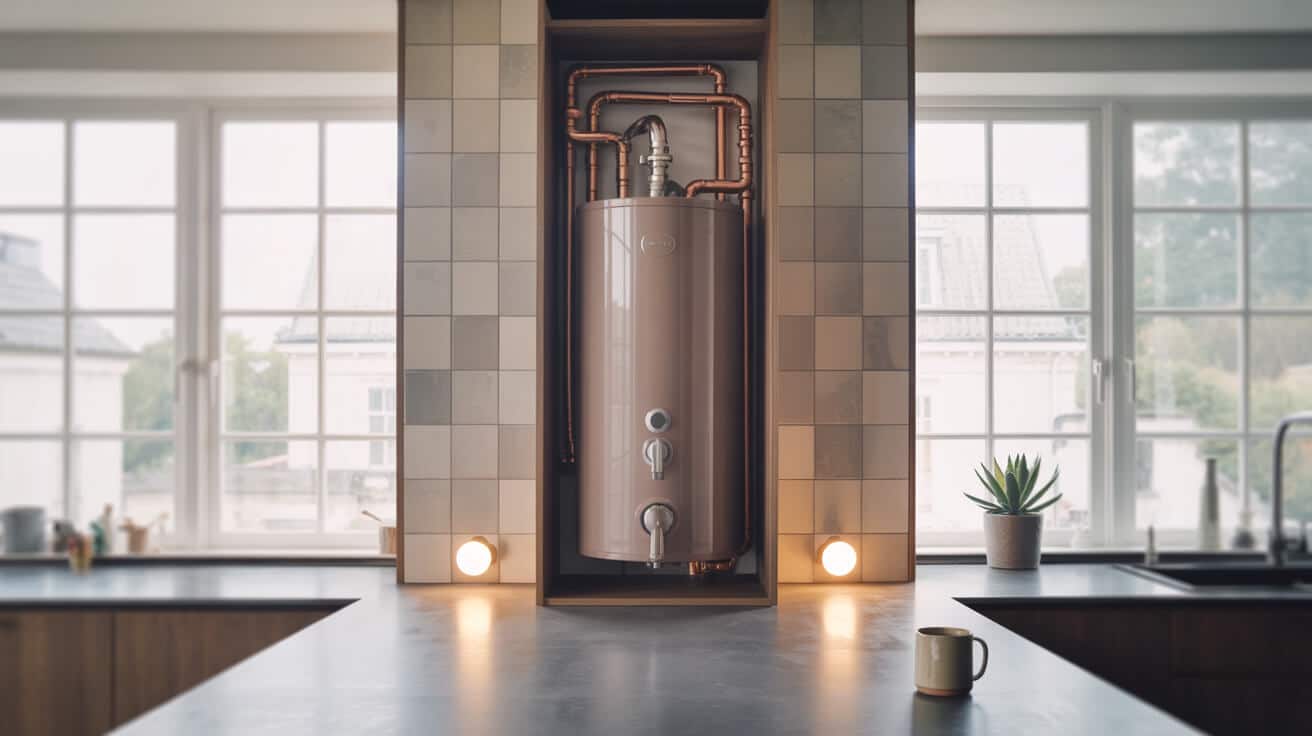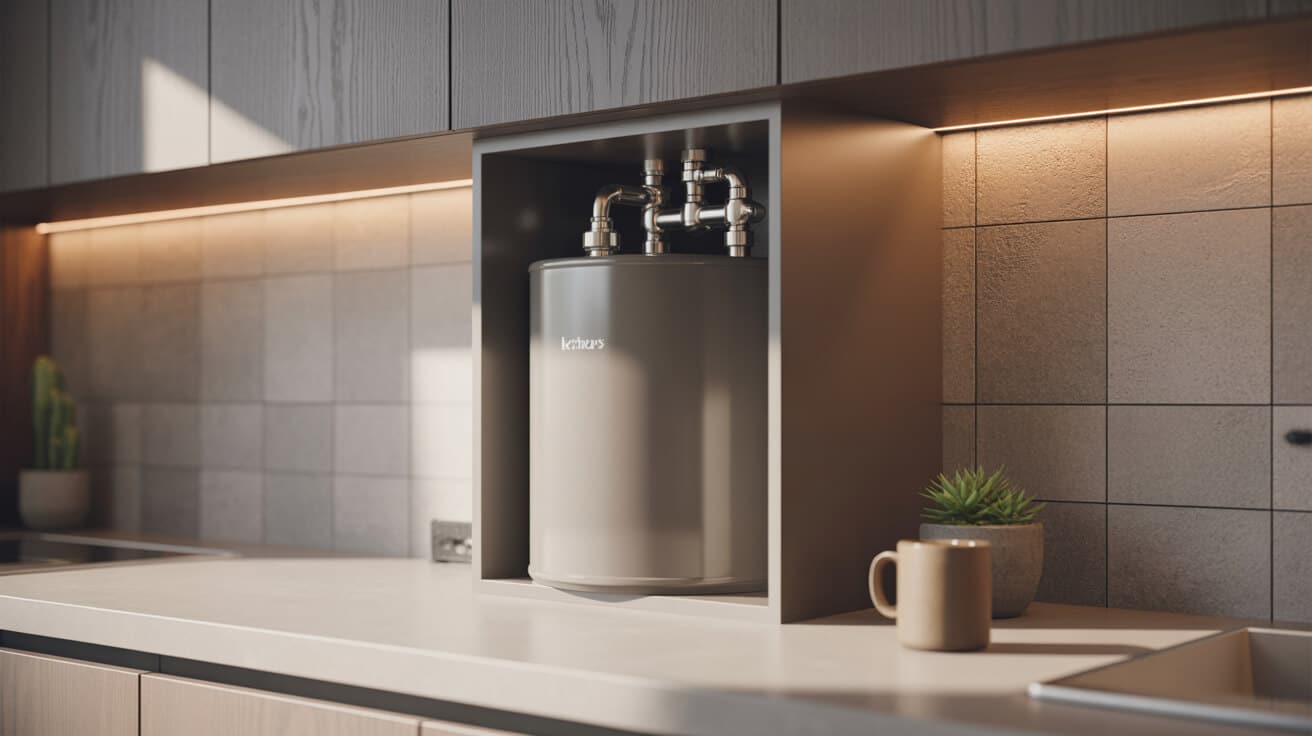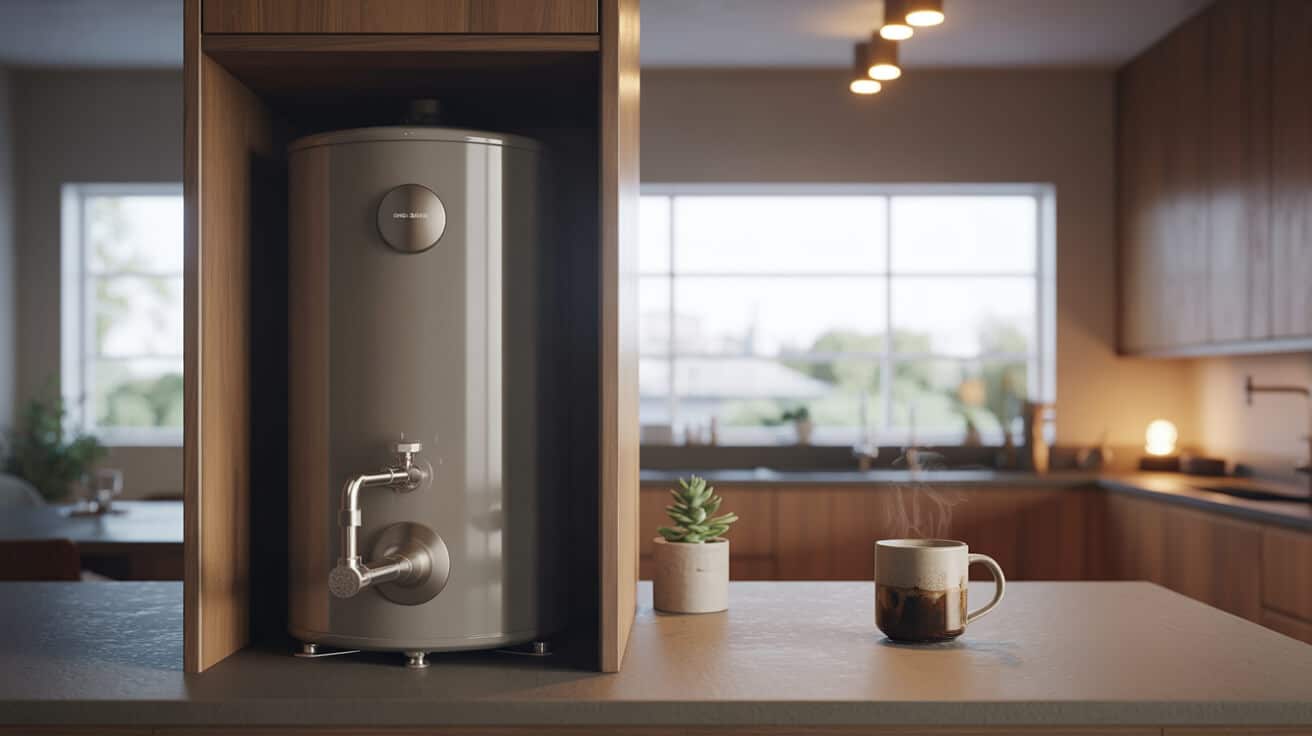Etymology or name origin
The term “unvented” describes a closed water storage system that remains isolated from atmospheric pressure, distinguishing it fundamentally from traditional “vented” arrangements where water enters via a gravity-fed cistern and open vent pipe. “Cylinder” refers to the vessel’s pressure-rated construction, which can be direct—where water is heated inside the tank—or indirect, where heat is transferred via an internal coil. Originating in regulatory and technical literature from the late twentieth century, “unvented” serves as both a functional descriptor and a classification under United Kingdom water safety codes.
Overview and context
Unvented hot water storage defines contemporary expectations for pressurised hot water delivery in residential, commercial, and institutional environments. Within the United Kingdom’s plumbing sector, these systems are now considered standard for new-build and premium retrofit projects, replacing large header tanks and cumbersome pipework with neat, integrated solutions. Advancements in water hygiene, temperature control, and system integrity have positioned unvented cylinders as a preferred choice for properties seeking reliable performance and minimal maintenance risk. Your organisation may elect to instal such a system to optimise plumbing infrastructure, achieve regulatory compliance, and enhance end-user safety and satisfaction.
United Kingdom building services
The integration of unvented cylinders enables your property to maximise water pressure and delivery regardless of outlet elevation or demand. Eliminating dependence on elevated tanks conserves space and reduces legionella risk, streamlining the plumbing design in both single-unit residences and multi-storey developments.
Residential versus commercial use
While domestic installations often focus on rapid bath and shower fill rates and simultaneous supply to multiple outlets, commercial and institutional installations prioritise scalability, anti-legionella management, and adapted service intervals. Facilities managers and landlords employ unvented systems to support hygiene, rental compliance, and high daily throughput.
Industry positioning
Companies such as Plumbers 4U have revised plumbing and heating service models to favour unvented system deployment for clients with adequate water supply infrastructure. Your property’s specific requirements—ranging from space constraints to renewable energy integration—are best served through a robust site assessment and system selection process by certified professionals.
History
Early hot water storage concepts
Domestically, traditional gravity-fed tanks dominated British construction until the late twentieth century, limiting hot water pressure and requiring elevated “header” installations. Open venting controlled overpressure, but introduced contamination and temperature inconsistency, leading to user complaints and maintenance demands.
Regulatory and safety-led innovation
The introduction of pressurised (sealed) hot water storage in the 1980s and 1990s corresponded with advances in metallurgy, thermal controls, and water safety awareness. Early incidents of overpressure and expansion-related injuries prompted legislative and technical standards including BS 6700, EN 12897, and later, the United Kingdom Building Regulations’ G3 provisions.
Standardisation and installer training
As the market matured, installer certification and oversight became critical. National regulation now demands all unvented cylinder installations be performed by professionals holding a G3 unvented qualification, subject to Building Control notification and inspection. Organisation such as WRAS and WaterSafe have played key roles in developing training frameworks to assure end-to-end safety and compliance.

Concept and description
Principles of operation
An unvented hot water cylinder accepts cold, mains-pressure water via an inlet control group, gradually heating the stored volume using an electric immersion element (direct) or an internal coil linked to an external boiler (indirect). Water expands when heated; in a closed, unvented arrangement, this expansion is safely contained in an expansion vessel, preventing dangerous overpressure.
Main components
Key elements of a typical installation include:
- Cylinder vessel: Stainless steel or glass-lined steel construction, heavily insulated and corrosion-resistant.
- Expansion vessel: A bladder or diaphragm-based chamber absorbing increases in water volume during heating cycles.
- TPRV (Temperature & Pressure Relief Valve): Discharges water safely if temperature or internal pressure exceeds preset thresholds.
- Pressure-reducing valve: Stabilises high incoming mains pressure for system protection.
- Non-return valve: Ensures water does not flow backwards toward the supply.
- Immersion heater: Electric heating element (direct models) or backup for loss of external heat source.
- Thermostatic mixing valve (TMV): Optional component, blends hot and cold for anti-scald assurance.
- Discharge pipework: Routes excess water to an exterior, visible termination point to prevent hidden leaks.
System variants
Systems may be direct, indirect, or “twin coil” (with an additional solar/renewables circuit). Some models enable secondary hot water circulation for rapid delivery, especially in complex domestic or high-volume commercial setups. Smart control modules, integrated with timers or external monitoring platforms, exist for energy management and maintenance optimization.
Functionality, purpose, and applications
Intended uses
Unvented cylinders are specified in new builds, major renovations, executive residential properties, hotels, schools, healthcare settings, and any site needing high-pressure, multi-outlet hot water. Your decision to specify such a solution typically hinges on:
- Routine demand analysis (number of showers, baths, kitchens, and simultaneous use).
- Available mains water pressure and flow, measured during site survey.
- Regulatory and insurance context (e.g., rental property compliance).
Performance and advantages
These systems offer instantly available hot water at uniform pressure across all outlets, enabling simultaneous use by multiple residents or users. Their single-vessel, closed configuration greatly reduces risks of stagnation and bacterial contamination. By removing header tanks, they allow for streamlined architectural design and greater flexibility in property layout and expansion.
Energy efficiency and operational benefit
Modern models employ dense polyurethane insulation and precision controls to minimise standing heat loss and optimise recovery rates. When integrated with renewable sources, such as solar thermal panels or air-source heat pumps, users and organisations can reduce running costs and their carbon footprint while enhancing regulatory compliance.
Types and classifications
Direct and indirect models
- Direct cylinders: Heated by immersion electric elements within the tank. Typically suitable where gas is unavailable or as a backup to renewable sources.
- Indirect cylinders: Water is heated by an internal coil connected to an external boiler or heat pump; the immersion element can serve as a backup.
Sizing and system selection
Proper sizing is critical:
- Small apartments: ~120–150 L
- Family homes: ~180–250 L
- Multi-bath properties and small hotels: Up to 500 L or multiple linked units
If your property features a high number of simultaneous demand events (e.g., gym, school), expert calculation of peak flow and recovery time is essential.
Renewables integration
Twin coil cylinders enable futureproofing against policy changes or sustainability targets. One coil connects to the boiler, the other to a solar collector or heat pump. This design supports decarbonisation initiatives and provides resilience against fluctuating energy supply costs.
Installation methods and practices
Pre-installation assessment
Qualified engineers conduct comprehensive site surveys to verify:
- Adequate mains infrastructure (pressure >2 bar recommended)
- Compliance with local building, electrical, and water bylaws
- Feasibility of exterior discharge (for TPRV)
- Access for ongoing service
Installation workflow
- Identify installation location, checking floor strength and accessibility.
- Secure cylinder base and vertical alignment per manufacturer’s instructions.
- Connect cold water supply via a pressure-reducing/inlet group assembly.
- Fit expansion vessel, using mounting brackets and correct pre-charge pressure.
- Instal and test all valves (TPRV, pressure relief, non-return).
- Connect discharge pipework (using copper, with visible exterior termination).
- Integrate heating circuit (boiler pipework or electric supply as appropriate).
- Complete electrical bonding, adapt immersion wiring, and U.K. Part P compliance.
- Fill, vent, and pressurise system.
- Commission system, verify all safeties, and annotate benchmark logbook.
Documentation and commissioning
Comprehensive commissioning includes operational testing, system bleed, pressure/temperature functional checks, and regulatory documentation. Plumbers 4U provides clients with a completed logbook, warranty guidance, and Building Control notification record as a matter of standard service.
Retrofits, upgrades, and special circumstances
In older buildings, adaptation of pipework, compliance with fire barriers, and careful routing of new discharge lines may be required. Space-constrained sites may necessitate horizontal or slimline cylinder models; specialist advice helps you ensure durable, safe upgrades with minimal disruption.

Tools, materials, and standards
Essential tools
Installations rely on:
- Torque wrenches for mechanical joint tightness
- Pipe benders and cutters (copper and plastic)
- Pressure and flow rate testers
- thermal imaging and moisture testing (for leak diagnostics)
- Multimeters (electrical commissioning)
Materials and regulatory demands
All fittings, vessels, and pipework must carry WRAS (Water Regulations Advisory Scheme) approval; insulation meets minimum “U-value” standards set by Part L of the Building Regulations. Plumbers 4U ensures that only compliant materials reach your project.
Logbooks and manufacturer guidelines
Benchmark logbooks, supply-part certification, and service records support not only warranty integrity but also your compliance with landlord and insurance stipulations.
Stakeholders and specialist roles
Qualified installers
G3 Unvented Hot Water qualification is legally mandated for any engineer undertaking unvented installations or servicing. NVQ Level 3, WaterSafe, and manufacturer-specific accreditations are widely required in the professional sector.
Training and oversight bodies
Building Control officers ensure the correct completion of notifiable works. CIPHE and WaterSafe both maintain public registers of qualified installers and promote professional development. Plumbers 4U’s commitment to training ensures that our clients receive installations aligned with evolving technical standards.
Property managers, landlords, and end-users
Building managers, letting agents, and private owners are all legally responsible for commissioning, storing, and producing documentary proof of compliant system installation and regular maintenance in tenanted and commercial properties.
Legal, regulatory, and safety considerations
Key regulatory frameworks
- Building Regulations Part G: and G3 (England and Wales): Set standards for maximum water temperature, provisions for pressure relief, and require notification and sign-off by local authority or approved inspector.
- WRAS (UK Water Regulations): Mandate the use of compliant plumbing fittings and correct backflow prevention devices.
- Health and safety legislation: Includes obligations on landlords, facilities managers, and service providers to maintain safe water systems.
Installer and organisational duties
All installation, commissioning, and servicing of unvented hot water systems must be performed by a G3-qualified individual, with documentary evidence required for insurance and regulatory compliance. Failure to comply may void your policy or expose your organisation to legal risk.
Safety architecture
Redundant safety devices (expansion vessels, TPRV, dual thermostats, and visible discharge routes) are standard. The system’s closed nature and powerful energy storage necessitate rigorous attention to:
- Scald protection (thermostatic mixing, temperature caps)
- Legionella control (system temperatures above 60°C)
- Visible, witnessed discharge arrangement (never to soil or communal pipes)
Documentation and legal notification
Each installation must be logged with Building Control and be presentable on request by inspectors, your insurer, or new tenants. Plumbers 4U’s protocol includes digital archiving of all installation and commissioning data.
Performance and maintenance
Operations and monitoring
The unvented cylinder is designed for operating pressures around 2–3 bar. Routine tests check pressure relief setting, expansion vessel pre-charge, and control thermostat calibration. Water quality monitoring is recommended for hard water areas to avoid limescale-related performance decline.
Servicing intervals and methods
Annual professional servicing is considered the industry minimum; landlords and commercial property managers may require inspection at shorter intervals depending on use intensity and regulation.
Standard maintenance includes:
- Testing all valves and safeties
- Flushing to reduce sludge or sediment
- Checking for leaks, pressure drops, or standing loss
- Review of documentary and regulatory compliance
Troubleshooting
Common faults include dripping TPRV (indicative of overpressure, failed expansion vessel, or thermostat error), lack of hot water (failed element, cutout, or boiler error), and leaks at joints or discharge connections. A qualified engineer’s intervention is always recommended to avoid escalation or system compromise.
Challenges and limitations
Technical limits
Properties with insufficient mains pressure or ageing infrastructure may require upgrades before system installation. Discharge pipe-routing, physical access, and weight on upper floors can all constrain system selection.
Regulatory barriers
Failure to notify local authorities, improper commissioning, or omitting safety devices can lead to failed inspection, insurance exclusion, or regulatory penalty. Landlords must ensure regular maintenance to avoid legal challenges from tenants or authorities.
Operational risks
Improper temperature setting, disabling safeties, or unauthorised repairs can result in dangerous overpressure or scalding incidents. User education, robust handover processes, and professional aftercare are paramount for long-term safety.
Impact, influence, and legacy
Changing industry standards
The widespread adoption of unvented systems in your sector has led to heightened expectations for pressure performance, comfort, and compliance. Plumbers 4U’s focus on continuous training, digital data management, and transparent handover has contributed to this transformation.
Building value and experience
Modern hot water convenience, enhanced safety, and space efficiency enhance the property experience for your tenants, families, or occupants. Proper documentation supports both insurance and regulatory compliance, offering peace of mind.
Societal and user attitudes
Greater public and professional awareness of the importance of safe, accredited installation—and recognition of the value provided by documented, certified systems—have raised industry benchmarks.
Future directions, cultural relevance, and design discourse
Technological innovation is driving the next phase of unvented system design. Emerging trends include:
- Smart sensors and predictive servicing: , enabling your business to anticipate maintenance and reduce downtime.
- Eco-compatible cylinders: with improved thermal retention or compatibility with renewable heat sources, supporting decarbonisation goals.
- Compact and aesthetic solutions: for dense urban development.
- Regulatory adaptations: that mirror what is possible with better digital documentation, system monitoring, and notification.
- Cultural shift towards compliance: and risk ancestry, where both owners and service providers prioritise verifiable safety as part of property value.
The evolution of unvented hot water cylinder installation reflects both contemporary performance requirements and the growing societal drive towards efficiency, risk reduction, and architectural adaptability.

